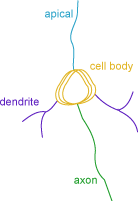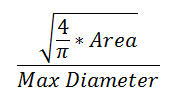Neuron summary (branched structure)
The neuron summary provides a quick overview of the selected neuron components: axons, dendrites, and cell body.
The overview includes lengths, areas, volumes, quantities, and complexity. Quantities include the number of nodes, terminations, and spines on the branched structures.

Analysis results
Neuron Summary
- Cell body: Total perimeter for all cell bodies included in the analysis.
- Dendrites/Axons: Total length for all branched structures of a given type.
The surface area is modeled as a series of cylindrical sections capped by the end profiles.
Surface Area per Cylinder = [Perimeter of the profile] * [Distance to the next profile]
Calculated for 2+ cell bodies.
|
The calculations are based on this principle: Two stacks with the same number of sections and the same thickness for each section have the same volume. |

|
- Cell body: [Area of the profile] * [Distance to the next profile] — (only available for 2+ cell bodies)
- Dendrite/axon: Computed by modeling each piece of each branch as a frustum.
|
The calculations for the cell body are based on this principle: Two stacks with the same number of sections and the same thickness for each section have the same volume. |

|
If there's more than one object of a given type, Neurolucida Explorer generates the mean for Length, Area, Surface, Volume.
The area refers to 2-dimensional data while surface refers to 3-dimensional data.
Cell Body Details
Length of the contour representing the cell body.
Refers to the 2-dimensional cross-sectional area contained within the boundary of the cell body.
Aspect Ratio = [Min diameter] / [Max diameter]
Indicates the degree of flatness of the cell body:
- Range of values is 0-1.
- A circle has an aspect ratio of 1.

|
|
Convexity = [Convex Perimeter] / [Perimeter]
- A completely convex object does not have indentations, and has a convexity value of 1 (e.g., circles, ellipses, and squares).
- Concave objects have convexity values less than 1.
- Contours with low convexity have a large boundary between inside and outside areas.

|
The form factor differs from the compactness by considering the complexity of the perimeter of the object. For example, a circle with a smooth perimeter has a compactness of 1 and a form factor of 1. If the smooth perimeter is replaced with a finely jagged edge (like a cell covered in microvilli), the compactness is still near 1, but the form factor is much smaller since the perimeter is lengthened considerably.
|
Roundness = [Compactness]2
Use to differentiate objects that have small compactness values.
Solidity = [Area] / [Convex Area]
The area enclosed by a ‘rubber band’ stretched around a contour is called the convex area.
- Circles, squares, and ellipses have a solidity of 1.
- Indentations in the contour take area away from the convex area, decreasing the actual area within the contour.
It is possible to have contours with low convexity and high solidity, and vice versa.
The calculations for cell body are similar to the calculations used for contours: see Contour Measurements in Neurolucida.
3D cell bodies


